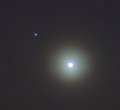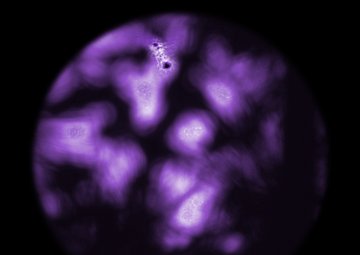 Did you miss the aurora storms of Sept.? Next time get a wake-up call: Sign up for SpaceWeather PHONE.
Did you miss the aurora storms of Sept.? Next time get a wake-up call: Sign up for SpaceWeather PHONE.
SOLAR ACTIVITY: Sunspot 822 remains active, producing daily M-class solar flares. So far none of the explosions has hurled a coronal mass ejection (CME) toward Earth. As a result, auroras are therefore unlikely during the next 36 to 48 hours.
 VENUS AND NUNKI: When the sun goes down tonight, step outside and look south. See that star very close to Venus? That's Nunki, a blue giant five times wider than the sun and 3300 times more luminous. It only looks dim because it is far away, 224 light years. Side by side, Venus and Nunki are a pretty pair: sky map.
VENUS AND NUNKI: When the sun goes down tonight, step outside and look south. See that star very close to Venus? That's Nunki, a blue giant five times wider than the sun and 3300 times more luminous. It only looks dim because it is far away, 224 light years. Side by side, Venus and Nunki are a pretty pair: sky map.
Above: Venus and Nunki on Nov. 17th. "A thin layer of clouds made a beautiful corona around Venus," says photographer Maxime Spano of Marseille, France.
SUNRISE (1): "As the sun rose this morning [Nov. 15th], I captured this picture through some nearby pine trees," says Gary Palmer of Los Angeles, California:

Why is the sun purple? Palmer took the picture using a "CaK" filter tuned to the violet glow of singly-ionized calcium in the sun's atmosphere. CaK filters reveal intense magnetic fields--the stuff of sunspots. Look between the branches near the top of the disk. That's giant 'spot 822.
"Each day is a new adventure," says Palmer. "You never know what you're going to see."
SUNRISE (2): When the sun rose yesterday over Falls City, Nebraska, it looked like a volcano was erupting:

"My six year old was shocked when he stepped outside to go to school and saw this column in the eastern sky," says photographer Jerry D. Chab.
No need for alarm, it was just a sun pillar. Ice crystals floating in cold clouds catch the rays of the rising sun and spread them into a narrow up-and-down shaft of light. These pillars can be seen many mornings within 30 minutes of dawn.

